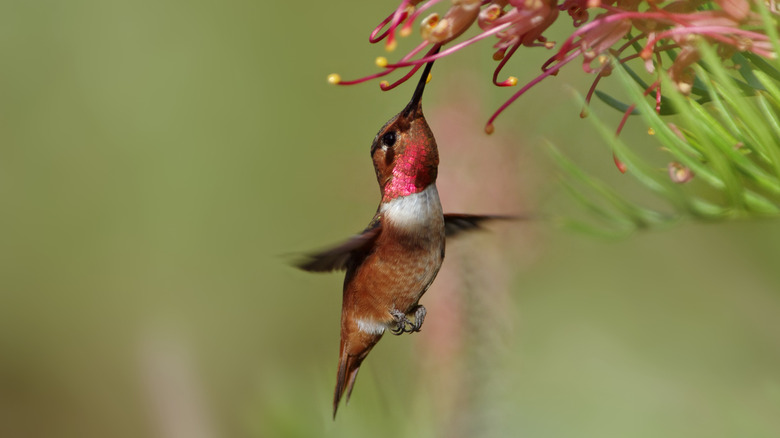Bring A Tropical Vibe To Your Garden With A Red Flower Hummingbirds Love
Few things light up a garden like a flash of hummingbird wings, and nothing draws them in faster than the right kind of flower. The red bird of paradise (Caesalpinia pulcherrima) is a tropical shrub that produces a display of vibrant orange-red blooms packed with nectar. These fiery flowers act like magnets for hummingbirds, thanks to their color, shape, and steady supply of sugary fuel. Once it starts blooming, it draws the fast-flying, high-energy hummingbirds that rely on nectar to power their nonstop movement.
This eye-catching plant, sometimes called pride of Barbados or peacock flower, is native to tropical regions of the Americas and thrives in heat. Its flowers bloom in big sprays, with frilly petals and long, bright red stamens that extend far beyond the blossom, making each cluster appear almost electric in the sun. Hummingbirds are naturally drawn to red and orange tones, and this shrub delivers both in abundance throughout the warmer months. As they hover and sip from the flowers, they also help with pollination, giving the rest of your garden a healthy boost.
Beyond its role as a hummingbird favorite, the red bird of paradise brings strong ornamental value. It has soft, fern-like foliage and a loose, branching shape that can grow over 10 feet tall and wide in warm climates. Its spiny stems give it a natural deterrent quality, which is why it's been used as a living fence. With its constant color, pollinator appeal, and beautiful structure, this sunny flower that attracts hummingbirds makes it easy to turn any bright yard into a tropical haven.
Growing and caring for red bird of paradise in your garden
The red bird of paradise plant thrives in tropical and subtropical conditions, making it ideal for warm-climate gardens. This sun-loving shrub grows best in USDA Hardiness Zones 9 to 11, where it can stay evergreen year-round. In Zone 8 or during light frosts, the top may die back, but the roots often survive and regrow in spring. In colder regions, you can move it inside before freezing temperatures hit if you plant it in a container.
Choose a full-sun location for the best flower display. This plant loves heat and often performs even better near a sunny wall or patio. It needs well-drained soil and won't tolerate soggy roots. Once established, it's drought-tolerant and needs only occasional deep watering. Prune lightly in spring to encourage bushier growth and more blooms.
It is generally trouble-free and resists deer, though you may occasionally spot whiteflies, mealybugs, or glasshouse red spider mites. Mature plants can reach 10 to 20 feet tall and 6 to 12 feet wide, so give them plenty of room. However, make sure to keep this plant out of reach of pets, as all parts are toxic to both cats and dogs if ingested.

